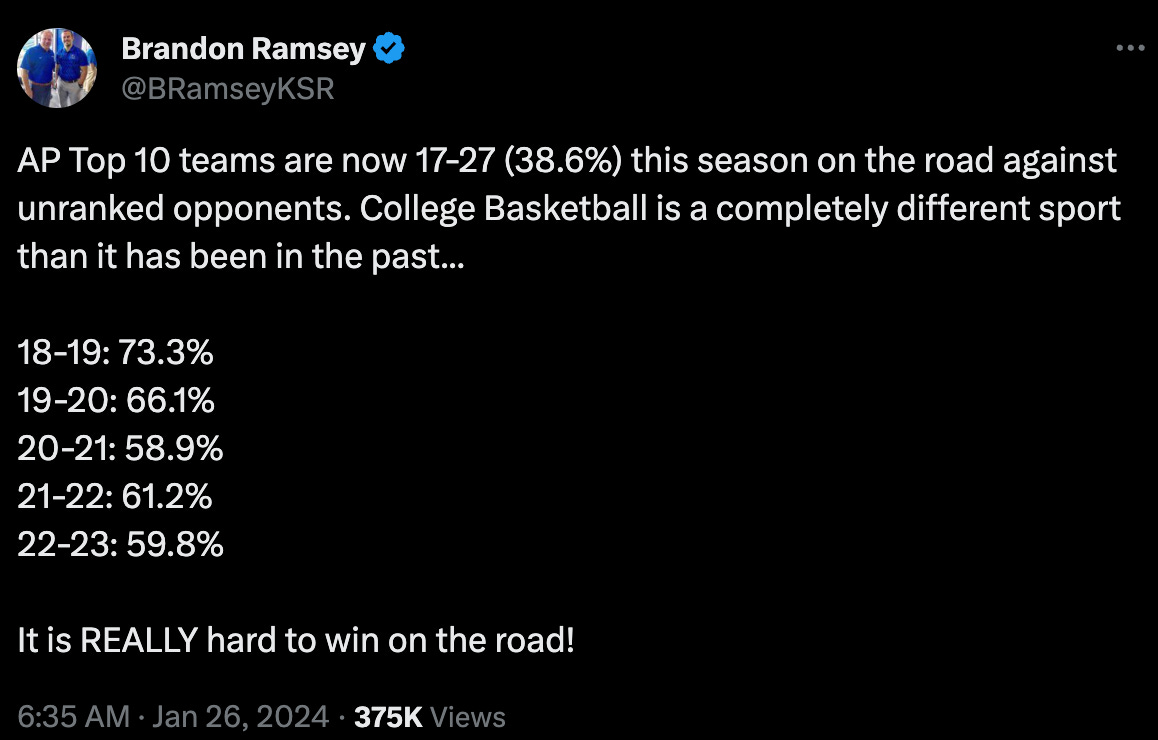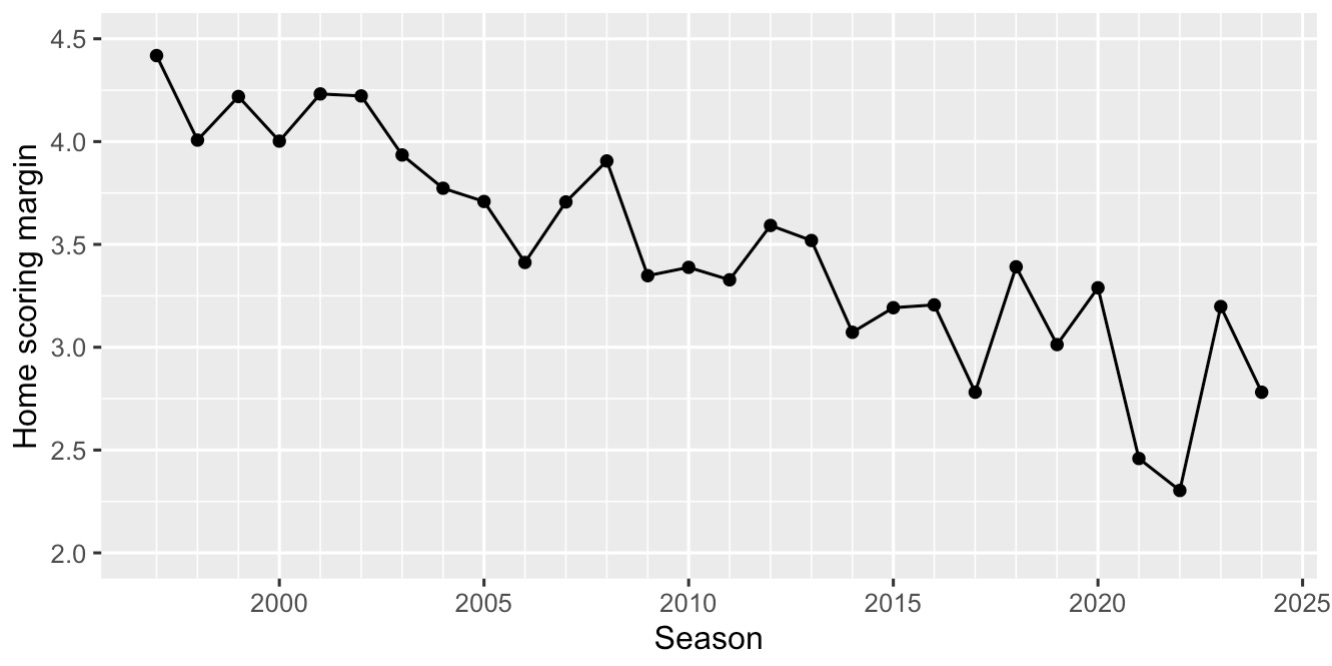There are fun facts, there are meaningful facts, and then there are the facts that fall into a murky area of facts presented as meaningful that are merely fun. With a little critical thinking, you can see through the latter. But who has time for that in our modern, fast-paced society? Besides, the fact-maker just has to fool a few people and before you know it, PTI turns the fact into a talking point.
So market forces encourage such pieces of information. For instance, Walter Sharp has made a decent living peddling such info on the football side. But in all sports, this business is booming. The latest shocking piece of information in college basketball is some variation of this:
Whether it’s really hard to win on the road is pretty subjective. Like, home court advantage exists, and it’s important, but it’s not nearly as important in college basketball as it is in say, Nigerian football. Over last decade, about 40% of conference games have been won by the road team.
Before we start our deconstruction of this fun fact, we should already be skeptical whether this is a meaningful fact. Home-court advantage is largely derived from officiating biases. Fouls are slightly biased towards the home team, which pushes the advantage towards the home team, all things being equal.
After decades of steadily declining home court advantage, likely due to more sophisticated video tools to evaluate officials, replay reviews of crucial calls, and smaller crowds, what’s the explanation that all of this would suddenly get reversed in a single season? Like the NFL intentionally assigning a specific official to the AFC Championship game to ensure a Chiefs win, it would be a bombshell story if true.
As with the NFL officiating “controversy”, this one is pretty easy to put to bed. Let’s start with…
We’re using the AP poll
Using the AP poll for this fact was, I’m sure, convenient. But as we know, the AP poll is not a ranking of the quality of the teams in it. The result is that games like Kansas’s loss at Iowa State are included in this fact despite Iowa State being a five-point favorite before the game. Oddsmakers and the betting public seemed to think that the Cyclones were at least as good as the Jayhawks on a neutral floor, despite the former being unranked and the latter being in the top five at game time.
There are still legitimately shocking results in this group like Arizona’s loss at Oregon State on January 25th. Still, I don’t think there wasn’t anything special about the road environment. Do we really think the listed crowd of 4,239 at Gill Coliseum played a special role in the outcome that they wouldn’t have played in previous seasons? We don’t have to get overly analytical here. Crazy stuff happens in college basketball from time to time.
If you use a ranking system that, ahem, tries to rank teams by their true ability, the results are less shocking. The Kansas win over Iowa State isn’t included and things like Alabama’s three road wins against teams outside the top 25 are. Here are the records of teams in my top ten (at the time of the game) who played at teams outside my top 25, since 2012:
season W L pct
2012 56 13 81.2
2013 49 20 71.0
2014 48 27 64.0
2015 74 16 82.2
2016 51 23 68.9
2017 56 16 77.8
2018 63 21 75.0
2019 57 12 82.6
2020 57 24 70.4
2021 40 20 66.7
2022 57 20 74.0
2023 53 25 67.9
2024 25 17 59.5So this season is still the worst winning percentage, but the 59.5% win rate is hardly as shocking as the 38.6% win rate using the AP poll. And there’s still some context missing from these numbers, which leads us to the second problem…
“Unranked” includes every team from #26 to #362
Another problem with using the AP poll is that one cannot make a distinction among unranked teams. But with my ratings we can, ahem, do that. That matters in this case. Let’s look at the total number of games where teams in my top ten played a road game at teams outside of my top 100:
season games
2012 33
2013 25
2014 22
2015 39
2016 18
2017 20
2018 26
2019 18
2020 22
2021 11
2022 22
2023 21
2024 10Through Monday, this season has had (by far - with the exception of the shorter 2021 season) the fewest games between the top ten and teams outside the top 100. (To the extent there’s a story, it’s that top-ten teams have lost four of these games.) Previous seasons are heavily influenced by these easier contests. When we exclude those games these are the records by season:
season W L pct
2012 28 8 77.8
2013 26 18 59.1
2014 27 26 50.9
2015 40 11 78.4
2016 36 20 64.3
2017 37 15 71.2
2018 38 20 65.5
2019 40 11 78.4
2020 38 21 64.4
2021 31 18 63.3
2022 36 19 65.5
2023 32 25 56.1
2024 19 13 59.4Once we just look at the top-ten teams playing road games against teams ranked in the 26 to 100 range, the winning percentage doesn’t stand out. It’s on the low side, but this season is currently beating three of the previous 12 seasons. Eventually, more of those games against teams outside the top 100 are going to happen. UConn plays at DePaul and Georgetown in the next week. Tennessee will have games at Arkansas and Missouri soon.
Then we’ll find that home court advantage isn’t significantly different than in recent seasons. You could also just look at all games see this. Tuesday night was not a good night for road teams, highlighted by Clemson winning its second-ever game at North Carolina. But also, Iowa State, Nevada, Florida State, Rutgers, and Indiana won games as road underdogs. And that doesn’t count Wake Forest winning by 29 at Georgia Tech.
On the season, home teams have won 59.4% of conference games, which is actually slightly down from last season’s 59.9%:
More strikingly, the average margin of victory for home teams in conference games has been 2.78 points. The only seasons with a lower value are 2021 (the pandemic season), and 2022 (pandemic hangover?).
So while there have been a few surprising results for highly-ranked teams on the road this season, the struggles for top-ten teams are mostly a mirage, caused by quirks in AP voting philosophies and a lack of really easy opportunities that existed in previous seasons.






